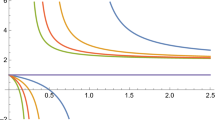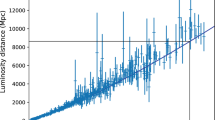Abstract
We prove here that Newton’s universal gravitation and momentum conservation laws together reproduce Weinberg’s relation. It is shown that the Hubble parameter H must be built in this relation, or equivalently the age of the Universe t. Using a wave-to-particle interaction technique we then prove that the speed of light c decreases with cosmological time, and that c is proportional to the Hubble parameter H. We see the expansion of the Universe as a local effect due to the LAB value of the speed of light c 0 taken as constant. We present a generalized red shift law and find a predicted acceleration for photons that agrees well with the result from Pioneer 10/11 anomalous acceleration. We finally present a cosmological model coherent with the above results that we call the Mass-Boom. It has a linear increase of mass m with time as a result of the speed of light c linear decrease with time, and the conservation of momentum mc. We obtain the baryonic mass parameter equal to the curvature parameter, Ω m =Ω k , so that the model is of the type of the Einstein static, closed, finite, spherical, unlimited, with zero cosmological constant. This model is the cosmological view as seen by photons, neutrinos, tachyons etc. in contrast with the local view, the LAB reference. Neither dark matter nor dark energy is required by this model. With an initial constant speed of light during a short time we get inflation (an exponential expansion). This converts, during the inflation time, the Planck’s fluctuation length of 10−33 cm to the present size of the Universe (about 1028 cm, constant from then on). Thereafter the Mass-Boom takes care to bring the initial values of the Universe (about 1015 gr) to the value at the present time of about 1055 gr.
Similar content being viewed by others
References
Adams, P.J.: Large numbers hypothesis. I. Classical formalism. Int. J. Theor. Phys. 21, 603 (1982)
Adams, P.J.: Large numbers hypothesis. II. Electromagnetic radiation. Int. J. Theor. Phys. 22, 421 (1983)
Alfonso-Faus, A.: Cosmology with time-varying G. Int. J. Theor. Phys. 25(3), 293–316 (1986)
Anderson, J.D., et al.: Indication, from Pioneer 10/11, Galileo, and Ulysses data, of an apparent anomalous, weak, long-range acceleration. Phys. Rev. Lett. 81, 2258 (1998)
Belinchón, J.A., Alfonso-Faus, A.: A theory of time-varying constants. Int. J. Mod. Phys. D 10, 299–310 (2001). arXiv:gr-qc/0404044
Sidharth, B.G.: The Universe of Chaos and Quanta, 8 February 1999. arXiv:qant-ph/9902028
Weinberg, S.: Gravitation and Cosmology. Wiley, New York (1972)
Author information
Authors and Affiliations
Corresponding author
Rights and permissions
About this article
Cite this article
Alfonso-Faus, A. The speed of light and the Hubble parameter: the Mass-Boom effect. Astrophys Space Sci 315, 25–29 (2008). https://doi.org/10.1007/s10509-008-9787-6
Received:
Accepted:
Published:
Issue Date:
DOI: https://doi.org/10.1007/s10509-008-9787-6




